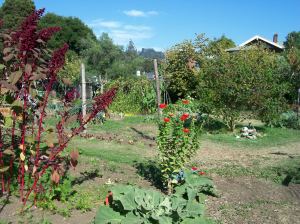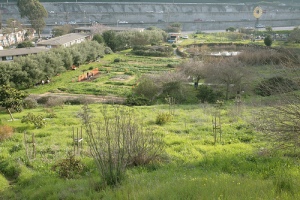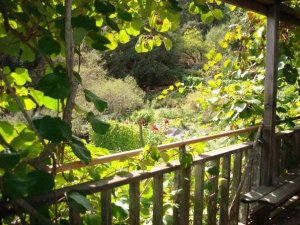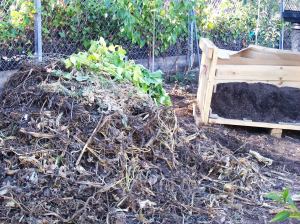Filed under: Uncategorized
-what the groups are up to and what progress we have on that
Animals- building chicken coop and bat houses
Canning- Caning free fruits and veggies from farmers markets
Blog- up and running from garden project site off of usfca.edu
Plastiki- protocol of garden
Veggie Stand- building stand
Rain catchment- getting system all set up for break and the winter months
Mural- constructing it and making signs for the plots of land
Compost- starting to produce
Food not bombs
-what we did during the garden workday
Weeding and tilling soil to plant cover crop
Construction on chicken coop and bat house
Lovely lunch with food from the garden
-explain about the garden philosophy plots now that their constructed and people can get a good visual of what it’s going to look like
Garden philosophies such as
No till
Bio dynamic
Eatable garden
Forrest gardening
Bio/French intensive
The hay to keep soil moist, warm, and birds out of the cover crop seeds
-talk more about the community plot of land and see if anyone would like to take charge of managing that
Point it our again and what they could possibly do again
-and ask if anyone else has anything that they want to be brought up.
Filed under: Uncategorized
Last Friday’s field trip to Brooks Park and Quesada Garden was rather refreshing. It was nice to see two gardens thriving that had been kept by groups who didn’t have a whole lot of knowledge about gardening. The whole trip gave me more confidence about starting my own garden sometime in the future when I have a space to.

The trip to Brooks Park was a bit nerve wracking due to the smoke that began billowing out of our van on the way, but the smoking eventually stopped and it made getting there just as sweet. The man who took care of most of the park was very energetic and enthusiastic about the park and garden. His happy-go-lucky approach to maintaining and growing there was echoed by the great wilderness area and thriving garden, as everything there seemed full of natural life. So far, Brooks Park is my first choice for an internship next year during the spring semester.

Next, we went to Quesada Garden. The small median strip garden was in a pretty sketchy neighborhood, however, the garden was bursting with green life that seemed to shine in the middle of a concrete area. It was amazing how such a simple thing, such as this garden, was able to bring together such an isolated community. Similar to Alemany Farm, it provided an alternative activity for at-risk youth that would be great to see in more underprivileged neighborhoods.
-Ryan Johnson
For more information on Brooks Parks, see http://www.youtube.com/watch?v=suS7-yqw9jI and for Quesada Gardens check out http://quesadagardensblog.blogspot.com/
Filed under: Uncategorized

This past Friday we visited the Edible Schoolyard in Berkeley. It was so amazing; I couldn’t believe how invested the students, not to mention the surrounding community was in the effort to promote organic living and sustainability. It is so important to teach the value of food to the next generation, especially in a time where fast food chains are a staple in many children’s diets. I was blown away at how engaged the students were, and how natural it was for them to work in the garden. It relieved them of stress and anxiety, while giving them a moment to be out in nature and experience the responsibility of nurturing things to life. It was a wonderful way to also gain community involvement. The volunteer’s all seemed very invested and very willing to work with the students, at a very rough age might I add as well.
I was especially impressed with the kitchen and how the students were able to harvest the food they grew, and learn how to cook it in a communal way. I really felt the sense of community and organic solidarity just watching the kids in their last few minutes of clean up. I think that it is so beneficial that they teach this collective living at a young age, especially when this “family atmosphere” has been diminished with the growing popularity of T.V dinners and fast food.
The second half of the trip, when we went to the sour kraut kitchen, I thought it was really interesting to learn the process of pickling. I had never seen or experienced anything quite like that except for the wine fermenting process I witness all the time back home. I was really interested especially in the kombucha. I didn’t have a chance to really ask much information about the benefits of the tea and what makes it naturally carbonated, but I have heard many nutritionists in the past rave about how important it is and how it is the “magical healer”. I would really be interested in learning more about that and other teas that have a positive benefit on the body.
Overall I had a really good time on the trip and though I feel as if I didn’t learn as much factual knowledge at the Eatable Schoolyard, I really got to feel what a community garden felt like with everyone working harmoniously together. I loved it and I believe that we can create that atmosphere within our own garden if we can get all the people who are interested actually involved.
-Lily Post
For more information on The Edible Schoolyard please visit http://www.edibleschoolyard.org/homepage.html.
Filed under: Uncategorized
Please see our newly uploaded community profiles at http://www.usfgardenproject.wordpress.com/about!
Filed under: Uncategorized
What the Garden Project has been up to:
-groups (compost, canning, orchard, plastiki, mushrooms, vegetable stand, etc.)
-garden philosophy sections in the garden (no-till, permaculture, French intensive, etc.)
What are we going to do with the food?
We’ve thought about donating some of our crops to non-profits like
1)Food Not Bombs
2) Haight Ashbury Food Program
(The vote for this issue has been postponed until we see the quantity of our harvest)
Farmer’s Market
How much food will go to the USF farmer’s market stand and how much will be donated?
-We don’t need to sell vegetables for funds, because we are funded by the school
-It was suggested that whatever produce isn’t sold at the market could be donated or perhaps we could donate the money made from the market
It was suggested that we should give sustenance to the people who work in the garden with perhaps community dinners.
Would have the quantity of produce needed to complete all the projects previously mentioned?
-members of last year’s Garden Project said that they had so much excess produce
-also it was suggested that we set a limit on picking (such as pick until this day, and then donate whatever is left)
-plus perhaps we can work with Bon Appétit and combine our excess for Food Not Bombs
A short-term plan mentioned was a Back to da Roots and Garden Project dinner
The lack of awareness of the organic garden on campus was also mentioned.
Talk about Garden Design
-a spot designated to last year’s G.P. (and the community?) behind the bulletin board by the pathway
-need to designate a community member to lead it
Suggestions on growing:
-mushrooms (Sporriors)
-perennials in permaculture
New Community Members
-Welcome to the Garden
-How can we help you get involved?
-suggestion of a staff orientation
Red tape on livestock initiative (although chickens are okay)
Suggestions:
-hang yellow tape on hanging wires
-maintain pathways and brickwork
-perhaps a staircase to counter the slippery hillside
-wood furniture needs preservative
-fix the mosaic on the shed (also perhaps paint the shade something less glaring than white)
-trim trees
-suggestion of using the mystery garden for the community and developed portion for G.P. students
-garden etiquette (designate someone for trash duty)
A better time for the community meetings?
-some people suggested off campus or weekend times
-Community can check the G.P. blog to stay connected
Mention Plastiki boat
-Coordination on campus Thursday Nov. 6th at 4pm (can be found in USF Connect)
REMINDER
Community Meetings- last Tuesday of every month
Work Day- November 8, 2008 (10am-2pm with lunch provided)
Hope to see you there!
Filed under: Uncategorized
The field trip to OAEC was by far our most fun and eye opening experience yet. Not only was seeing their beautiful garden inspiring, but our collaborate effort to turn the soil really showed just how much our group can do together in a short amount of time. Each experience where our class works together in the garden helps us to figure out each individual’s strengths, and that helps us to be more successful and efficient as a team.
Turning the soil was a new experience to me, I never knew what that activity consisted of, and so that was an important learning experience. It was inspiring to see how healthy soil can be when a lot of love and care and time is put into maintaining it’s health. Pretty much any crop could grow into that soil, it had living creatures thriving from its fruitfulness. Paulo informed us about permaculure, compost and soil maintenance throughout our hands on session. He said that soil requires specific care depending on what you’re trying to grow. He also told me that his three main ideas of permaculture were: care for the earth, care for the people, and fair share. When we were composting, it was interesting to actually see successful composting, as we have read about. They had a few piles in progress, and one big one, which we added straw, and green to. The ratio they used was three parts green, to one part brown, but I concluded that was due to their surplus of green resources.
During the tour of the land, it was interesting to hear about how a group of people had been spending around fifteen years at that land creating and maintaining the health of the garden. They are a non-profit and also work for profit, selling the land to themselves. It seemed their business was complex, but had very positive intentions. Their community was about as big as ours, and very functional in what they did, they began with little resources, and in time gained more, and with help from outside sources created a wonderful environment.
I really enjoyed getting out of the city and being immersed in the beautiful land, it is amazing how healthy and happy the earth and its people can be when they work together collaboratively. This trip was especially helpful with providing useful information about permaculure. Not only was I able to ask questions from experts, but also I was able to see permaculture practiced, which in turn helped me to understand the whole concept much better. Considering that is the report topic I was assigned, thank you for scheduling that field trip at such a convenient time!
It was nice having Golden’s group discussion, although I would have preferred doing that exercise at a time when we’re at school. This is because I wanted to get outside and explore on that beautiful day, and it was harder to focus on Golden’s discussion with such beautiful open land surrounding us. Being in that confined dark room when we were all tired, probably was not the most affective time to do that discussion, but as usual I appreciated his activities because they help to bring our group closer, and understand each other better.
My favorite part of the whole field trip hands down was the AMAZING food!!! That food reminded me of the food my mom and my oldest sister cook, filled with love and organic ingredients! I could physically feel the difference in my body from eating that food compared to the cafeteria, I felt so much healthier, and slept like a baby. Thank you both for making that experience possible, it was awesome!
-Anna Carey
For more information, check out their website http://www.oaec.org/.
Filed under: Activities
This week, Amy from Garden for the Environment came to talk to us about composting basics. She started by telling us some general facts about waste and composting; about 6-7 lbs of waster are produced by a person in one day. Also, it is best to model urban composting piles after the froest floor, which is full of layered organic matter. However, in the forest, it takes nearly 100 years to create a healyth 1 inch of soil. Then, Amy described the composting progress, which includes green matter, brown matter, moisture, air, and a minimum of 1 cubic yard of space. Green matter is high in nitrogen, while brown materials are crunchy and dried out. The best ratio for a compost pile is 3 parts brown to every 1 part green. As the compost pile matures, it gives off heat, the composting materials shrink, and begin to attract bacteria and other organisms. There are three different types of composting: passive, pit/trench, and active/hot composting. The first, passive composting, is basically putting anything and everything into a pile and waiting for it to rot. Pit, or trench, composting is achieved when a hole is dug in the ground, green and brown matter are put into the hole, and then covered with 8 inches to 1 foot of mud. The last type of composting, active composting, requires a specific temperature value to be reached in order to be successful. For three consecutive days, the pile must reach between 130 and 140 degrees.
Amy then discussed the different materials that can and cannot be composted. Materials that can be composted include: eggshells, fruits, vegetables, rice, green and brown materials, manure from a non-meat eating creature, non-glossy cardcoard, and fish. Meat, eggs, oil, dairy, bones, nonorganic matter, noxious weeds, and plants that have died from disease cannot be composted. Amy noted that during rainy months the compost can be covered with a lid. Also, compost piles should be comprised of alternating layers of brown and green materials, and the uppermost layer should be made of brown materials. Lastly, she informed us that red wigglers are the best worms for composting piles.
-Kathryn Jeanfreau
Filed under: Uncategorized
Hey Farmers,
Here’s a reminder of the events we have going on in November:
1. Community Garden Workday
In the USF Community Garden
Saturday, November 8th 10 AM-2 PM
Come join us for our second community garden workday! There will be food, fun, and of course, vegetables!
2. Community Garden Meeting
In the USF Community Garden
Tuesday, November 25th 12:30 PM
Come and join us for our second community garden meeting of the year. We’ll be further discussing where the harvest will go. E-mail enbairstow@dons.usfca.edu if you have any issues you want to discuss.
Filed under: Uncategorized
 “The trip to Alemany Farm (as well as the adventurous excursion getting there), was very exciting. One of the most striking aspects, again, was the richness of the soil, despite being located in the middle of the city, on the edge of the highway. One would think the pollution would adversely affect the beds, but as our guide shared with us, this is not the case, as the soil has been adequately cared for. The variety of the crops was inspiring, knowing that in our own garden we will not be limited, either, and the small creek nearby was a soothing touch in the garden. The formation of the acre(s) themselves, on the slight hill and behind housing, was an interesting configuration, and was what I felt to be a very informative look at society, and how easily gardens can be integrated into them.
“The trip to Alemany Farm (as well as the adventurous excursion getting there), was very exciting. One of the most striking aspects, again, was the richness of the soil, despite being located in the middle of the city, on the edge of the highway. One would think the pollution would adversely affect the beds, but as our guide shared with us, this is not the case, as the soil has been adequately cared for. The variety of the crops was inspiring, knowing that in our own garden we will not be limited, either, and the small creek nearby was a soothing touch in the garden. The formation of the acre(s) themselves, on the slight hill and behind housing, was an interesting configuration, and was what I felt to be a very informative look at society, and how easily gardens can be integrated into them.
The work we did was fun, as well: for my part, I worked at pulling up pumpkin vines and hula-hoing the soil. I am still working out my fear of spiders and other soil dwellers, and I feel (and hope) that the more we work with rich soil ourselves, the more tolerant I will become of these beneficial creatures. I still have an idyllic vision of myself working on a farm and living off the land one day, so I know I will need to embrace the insects that live in the soil. I hope that we can have them in our garden here at school one day, too, as they seem to be a sign of healthy earth.
Learning to clean the tools may be as crucial for caring for the plants, and it is reassuring that we are taught those skills, too, and not just introduced to tending the plants and vegetables in the garden. I felt that this fieldtrip (and the pie that followed) was an insightful look at how gardens can be successfully grown in the middle of the city, and that no matter how limiting our factors may seem (climate, location, slope, time, etc.), we are not at a dead end. There is much we can do still, and the passion I see in the people we visit, as well as the passion invested in their land and the fruits of their labor, is very inspiring. The work may be taxing, but everywhere we go and everyone we see proves to me again and again that it is worth it, and that the world needs it.”
-Jessica Cordova
For more information on Alemany Farm, please visit the website at http://www.alemanyfarm.org/.
Filed under: Uncategorized
Even though school has been in session for less than two months, the group has already accomplished so much. Check out our next few upcoming posts for information regarding the group’s field trips, accomplishments in and out of the garden, and online resources collected thus far. Also, don’t forget we hold USF COMMUNITY GARDEN MEETINGS ON THE LAST TUESDAY OF EACH MONTH AT 12:30 PM (NEXT ON 10/28) LOCATED IN THE USF COMMUNITY GARDEN ACROSS THE PARKING LOT FROM THE SCHOOL OF EDUCATION ON TURK STREET AND A COMMUNITY GARDEN WORK PARTY ON NOVEMBER 8TH FROM 10 AM-2 PM.
For any further questions or information, please don’t hesitate to contact Elyssa Bairstow (enbairstow@dons.usfca.edu) or Susanne Umbenhower (seumbenhower@dons.usfca.edu).




